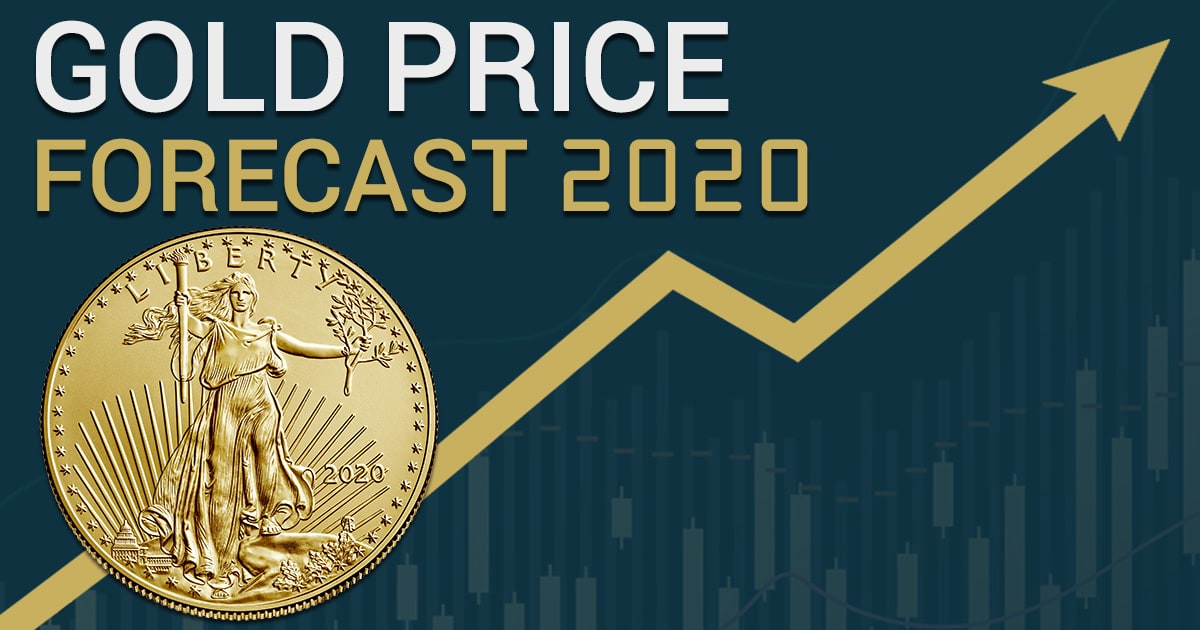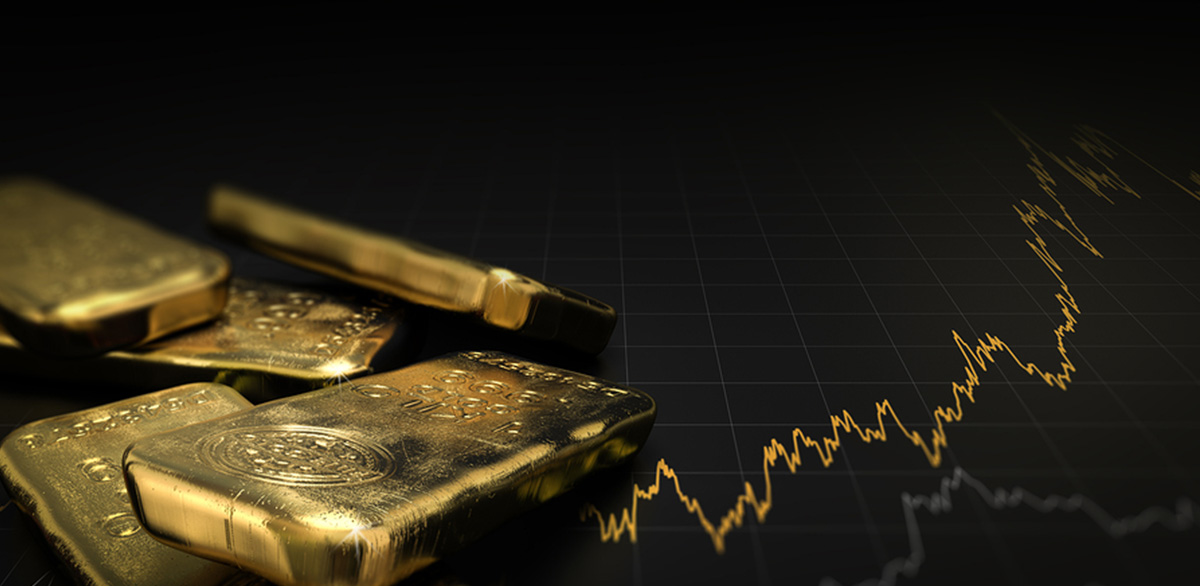
UPDATED: Gold Price Predictions for 2025
Will the price of gold go up or down in 2025? What trends should investors be watching? Read the forecasts here: Gold Price Forecast 2025
As it was predicted in the Gold Price Forecast 2019, the yellow metal rallied last year, soaring over 20% and hitting a six-year high of more than $1,560 an ounce. Only one other time in the last decade has gold seen such gains![1]
When the closing bells rang on December 31, 2019, the yellow metal was still up over 18% at $1,523.[2] Two weeks later, it jumped to $1,549.90.[3]
Will gold continue its upward trajectory? Industry analysts and experts as well as institutions think so, predicting gold and silver prices to rise in 2020.

Everything you need to know to get started in Precious Metals
Learn how precious metals can strengthen your portfolio, protect your assets and leverage inflation.
How high? Continue reading to find out.
Price Forecasts for Gold in 2020 and Beyond
Financial Institutions
‘An environment of negative and lower-for-longer real rates, slowing growth with downside risks, and elevated uncertainty strengthens the case for holding strategic gold allocations.’ — Swiss Bank UBS[4]
Financial Institution Gold Price Forecasts 2020
| Financial Institution | 2020 Gold Price Prediction (per ounce) |
|---|---|
| Swiss Bank UBS | $1,730 |
| Goldman Sachs | $1,650 |
| TD Securities | $2,000 |
| HSBC Securities Inc. | $1,605 |
| Standard Chartered Bank | $1,570 |
| Bank of America | $1,695 |
| Citi | $1,700 |
| ANZ Bank | $2,000 |
- Swiss Bank UBS predicts the price of gold in 2020 to hit $1,730. It’s a surprising gold forecast for the typically conservative financial institution, especially considering the bank raised its price expectations for the metal twice in less than two months. In addition to negative interest rates and the potential for a recession, UBS cited low volatility and continued, heavy institutional investing as reasons gold could shine this year.
Goldman Sachs’ gold price outlook for 2020 puts the metal at
$1,600, attributing a savings surplus due to an increase in precautionary cash balances and the 750 tons of gold central banks bought in a move away from the dollar and toward portfolio protection.[5]Other experts, however, “think Goldman is way off.” Paul Schatz, President of Heritage Capital, told Yahoo Finance’s “On The Move,”:
I think Goldman is way off here. $1,600 is going to be a footnote…I think gold is going to $2,500, $3,000/oz in the 2020s because the climate, the landscape for gold is so hugely supportive.–Paul Schatz, President of Heritage Capital[6]
- Canadian investment bank TD Securities forecasts the price of gold to surpass $1,650 an ounce by the end of 2020 and even go as high as $2,000 an ounce ‘due [to] a low rate environment, record debt, [and] U.S. election risks as we get closer to November along with insurance buying by central banks, portfolio managers and individuals.’[7][8]
Update: On March 17, 2020 Goldman Sachs analysts updated their 2020 gold price forecast from $1,600 an ounce to $1,650 an ounce, stating: “we maintain our bullish outlook on gold, as the larger-than-expected shock to the global economy will likely lead to greater risk aversion.” Goldman analysts outlook on gold prices for the next 3-12 months predicts gold prices at $1,600 an ounce in 3-months, $1,650 in 6-months, and $1,800 an ounce in 12-months.5.1
- HSBC Securities Inc. estimates gold prices to close at $1,605 in 2020. Along with Standard Chartered Bank, HSBC foresees the Federal Reserve cutting interest rates once more in 2020. Looser monetary policy across the globe, explains Chief Precious Metals Analyst, James Steel, geopolitical risks, and paltry yields will likely lift the price of gold this year.
- Retail investors seeking safe-haven assets in 2020 should push the price of gold to $1,570 by the fourth quarter, indicated Standard Chartered Bank’s precious metals analyst, Suki Cooper: ‘Retail investors almost want confirmation of further rate cuts, some weakness in the equity markets before they move into gold. The next leg higher in 2020 is going to be led by the retail side.’[9]
- Forecast updated on April 21, 2020: Bank of America, filed a report in which it raised its 18-month gold price target by 50%, from $2,000 an ounce to $3,000 an ounce. BofA forecasts gold bullion will average $1,695 an ounce in 2020 and $2,064 in 2021 due to gold supply and demand fundamentals and financial repression.ii
- Forecast added on March 17, 2020: ANZ, an Australian multinational banking and financial services company headquartered in Melbourne, Australia, published a report last week stating gold prices were undervalued. ANZ’s analysts forecast the price of gold spiking to $2,000 an ounce by the second quarter of 2020, and then leveling at the end the year to $1,700 an ounce.i
BONUS: A Gold Price Prediction for 2021:
The commodities research team at investment bank Citigroup thinks bullion markets could re-test the nominal price peaks of 2011-2012 to trade at between $1,800 and $2,000 by 2021 or 2022. Recall that gold prices set their best record in August 2011 of $1,900. What could help them beat it in the next couple years? A recession or economic downturn coupled with election uncertainty, indicates the bank.
Update on February 19, 2020: Citi analysts lifted their 6-to-12 month price target on gold to $1,700 per ounce.
Update on April 21, 2020: Bank of America lifted their 18 month price target on gold to $3,000 per ounce. They predict gold bullion will average $2,064 an ounce in 2021.
Update on December 15, 2020: We’ve been tracking gold price forecasts for 2021. Read the forecasts here: Gold Price Forecast 2021
Industry Analysts
‘There is so much boiling conflict, that gold being part of a portfolio makes sense to us,’ — Greg Jensen, Co-CIO of American investment management firm Bridgewater Associates.[10]
Industry Expert Gold Price Predictions 2020
| Industry Experts | 2020 Gold Price Prediction (per ounce) |
|---|---|
| Gov Capitol | $2,516 (by January 15, 2021) |
| Greg Jensen | $2,000 (or higher in the near future) |
| London Bullion Market Association | $1,658 |
| Jeffrey Gundlach | $1,700 |
| Paul Tudor Jones | $1,700 |
| Omkar Godbole | $1,850 |
| Jim Cramer | $1,800 |
- Utilizing a custom algorithm based on Deep Learning, Gov Capital, an investor blog, forecasts the price of gold to rise to $2,516 by January 15, 2021.[11]
The Co-CIO of Bridgewater Associates, Greg Jensen, thinks gold prices could spike 30 percent, soaring past $2,000 an ounce and setting new records. Similar to big banks and other industry analysts, he points to the Fed’s loose monetary policy as one reason for gold’s ascent.
Additionally, the yawning gap between the poor and the rich in America; tense U.S. relations with Iran, China, and other countries; rising inflation; trade deficits; and budget crises could not only serve as tailwinds for gold but even result in it replacing the U.S. dollar as the world’s reserve currency, argued Jensen.[12]
- Delegates for the London Bullion Market Association proved prescient when gold prices surpassed their 2018 prediction the metal would reach $1,532 in 2019. What do they foresee for the price of gold this year? $1,658 an ounce.[13]
- DoubleLine Capital CEO and known gold bug Jeffrey Gundlach forecasts the price of gold to hit $1,700 an ounce in 2020 as negative-yielding debt grips global markets, making the precious metal a more attractive investment. He explains, ‘With the yield of 0, gold has a higher yield than bonds. And if you store the gold, you now have a lower cost of carry on gold than you have on 10-year bonds.’[14]
- Paul Tudor Jones, Founder and Chief Investment Officer of Tudor Investment Corporation, said last June that his favorite investment in the next 12 to 24 months is gold, predicting the yellow metal to surge to $1,700 an ounce this year. Referring to the Fed’s return to interest rate cutting, Jones said, ‘It would make one think that rates in the United States go back down to the zero bound level and in the course of that situation, gold is going to scream. It will be the antidote institutionally for people with equity portfolios.’[15]
Omkar Godbole, an FXStreet.com analyst, forecasts the possibility of gold prices reaching $1,850 in 2020 due to continued dovishness at the Fed.
Not only is the central bank unlikely to start raising interest rates again after a series of cuts in 2019, but it’s expected to grow its balance sheet to a record high of more than $4.516 trillion by May 2020 while its counterparts around the world continue to adopt negative interest rate policies. Such actions, when considered together, give global markets little confidence in these institutions’ ability to bailout economies should another recession hit.[16]
- Jim Cramer, host of CNBC’s “Mad Money” expects good things for gold in 2020, as well, especially in light of escalating tensions between the U.S. and Iran. He explained, ‘It’s not just Treasuries. The gold buying has been endless; over and over and over. It feels like gold wants to go to $1,700 to $1,800. Now that would be very negative for the [stock] market.’[17]
📈 For yearly gold price forecasts see: Gold Price Predictions and Forecasts by Year
Where Do You Think Gold Prices Are Headed in 2020?
Share Your Gold Price Prediction for 2020:
Check the live gold spot price here.
What Market Factors Could Impact Gold Prices in 2020?

Several factors could influence gold prices in 2020. A small change in any area, particularly with the upcoming 2020 election, could have a significant impact on gold prices.
Potential Gold Price Movers in 2020
- The Global Economy.
- The US-China Trade War.
- Higher Demand for Gold Internationally.
- Lower Interest Rates.
- Stronger Emerging Money Markets.
- Inflation.
- Geopolitical Unrest.
Economic Factors
Experts have been predicting the record-long economic expansion to grind to halt for some time now, but is a full-fledged recession coming in 2020?
72% of Economists Forecast a Recession by 2021
In a survey of 226 of the top economists conducted last August, 38 percent foresaw a recession in 2020 and 34% expected one to hit by 2021.[18]
97% of Wall Street CFOs Predict Recession
The majority of the country’s chief financial officers see darker economic times on the horizon, with 97% indicating the downturn has already started or will begin this year in Deloitte’s most recent CFO Signals Survey. That’s up from 88% last year. Historically, such dreary sentiment on Wall Street has preceded recessions.[19]
Global Trade Tensions to Persist
The U.S.-China trade war dominated news headlines in 2018 and 2019, and, as we turn the corner into a new year, a breakthrough in negotiations has been made: in what has been described as ‘phase one’ of the trade deal between the U.S. and China, the latter country agreed to better police intellectual property theft and purchase billions in American agricultural products.
However, market analysts, economists, and trade experts remain skeptical the two countries can resolve the larger issues that drove President Trump to the verge of taxing nearly all Chinese imports, namely that country’s strong interference in its own economy.
And even if China and the U.S. do make more headway, strained trade relations between the U.S. and the E.U. and Great Brittan and the E.U. could weigh still on the global economy.[20]
Political Factors
U.S.-Iranian Conflicts
Assassinations, missile strikes, shot-down airliners, and endless threats—it’s a sequence of events fit for a suspense-thriller but, in fact, one describing current U.S.-Iranian political relations.
To make matters worse, the country announced it would no longer adhere to any of the limits outlined in the nuclear deal designed to prevent it from producing enough material to build an atomic bomb, and the U.N. and EU have threatened sanctions in response.
The situation puts the Middle East center stage in the global arena of political threats and will likely keep investors uneasy in 2020.[21]
Financial Factors
Goldman Sachs Sees Negative Rates for the U.S.
Should the much-anticipated recession or next financial crisis become market realities, the Fed could rely on negative interest rates as a last resort, indicates Goldman Sachs. With the federal funds rate at 1.5 – 1.75% , it wouldn’t take the Fed long to cut all the way down to 0.
‘If we were to see a recession at some point in the next few years, with interest rates close to where they are now, then you would only have 150 basis points or so for conventional interest rate cuts — that’s only about a third of the typical reduction in short-term rates,’ explained Jan Hatzius, the bank’s chief economist.
Why Is Gold a Good Investment in 2020?
In paradigm shifts, most people get caught overextended doing something overly popular and get really hurt.–Ray Dalio, Chair and Chief Investment Officer of Bridgewater Associates[22]
Big banks and industry analysts forecast gold prices to keep rising in 2020, with some even betting on the precious metal breaking records.
Bert Dohmen, of Dohmen Capital Research, has even gone so far as to predict gold could have a continuous secular bull market through 2030 based on his technical chart analysis. Given that the final stages of a bull market have historically been the most spectacular, the future could be especially bright for gold.
Ray Dalio warns that we’re in the midst of a paradigm shift, one in which investors could soon see the overvaluations and easy returns of a stock market propped up by nearly a decade of quantitative easing slip away as the limitations of the approach are reached. Interest rates simply have only so much lower to go before they hit zero.
If the gold price forecasts of the world’s biggest banks and industry analysts haven’t persuaded you that gold is a good investment in 2020, then perhaps the sage words of the world’s largest hedge fund manager will:
‘If you don’t have 5–10% of your assets in gold as a hedge, we’d suggest that you relook at this. Don’t let traditional biases, rather than an excellent analysis, stand in the way of you doing this.’
Will You Buy Gold Before the Next Price Jump?
What’s clear from these financial institution and industry expert predictions for the price of gold—and the myriad potential economic and political perils that could rattle markets in 2020—is that it’s not a matter of if prices will jump but when.
Will you buy before they do?
📚 Suggested Reading:


